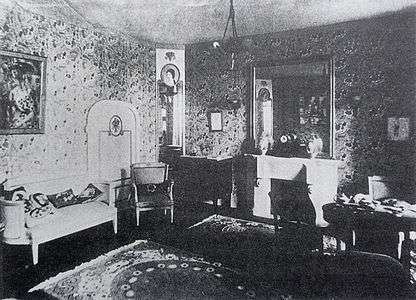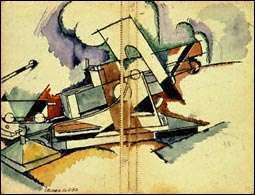André Mare
| André Mare | |
|---|---|
.jpg) André Mare (1885–1932) | |
| Born | 1885 |
| Died | 1932 |
| Nationality | French |
| Known for | Painting |
| Movement | Cubism |
| Elected | French Legion of Honour |
Charles André Mare (1885–1932), or André-Charles Mare, was a French painter and designer, and founder of the Company of French Art (la Compagnie des Arts Français) in 1919.
As a soldier in the French Army in World War I, Mare led the development of military camouflage, painting artillery using Cubism techniques to deceive the eye. His ink and watercolour painting Le canon de 280 camouflé (The Camouflaged 280 Gun) shows the close interplay of abstract art and military application at that time.[1] He authored the book Cubisme et Camouflage, 1914–1918.
Mare sketched and painted scenes based on his experiences in World War I. His works include: American Troops Marching Through the Arch of Triumph, 1930, and The Funeral of Marshal Foch, 1931.
As a painter and interior designer after the war, Mare combined his talents with the skills of architect Louis Sue and became a leader in the Art Deco movement of the early 20th century.
Life

Early life
Mare was born in Argentan in a typical Normandy family. He had a strict childhood and became a rebellious teenager, galloping on horseback to visit his grandparents or his childhood friend, Fernand Léger to discuss theories of art.
In 1904, he enrolled at the School of decorative arts.
In 1906, he exhibited at the Salon des Indépendants and the Salon d'Automne where he became one of the leading designers.
At the 1912 Salon d'Automne André Mare and Raymond Duchamp-Villon created—in collaboration with Marcel Duchamp, Jean Metzinger, Albert Gleizes, Marie Laurencin, Fernand Léger and Roger de La Fresnaye—La Maison Cubiste, which made his reputation.[3][4]
Guillaume Apollinaire early on noticed Mare's skill in designing furniture.[5]
War and camouflage

During the First World War, Mare worked on camouflage for the French army, in a section created by Lucien-Victor Guirand de Scevola and directed by his friend Dunoyer de Segonzac. He also worked for the British and Italian armies with his friend Fernand Léger and other painters including Forain, Charles Camoin, Charles Dufresne, Villon, and Marcoussis; and with the sculptors Henri Bouchard and Charles Despiau—and with stage designers from the theatre.
Mare applied the principles of disruptive coloration camouflage using forms derived from Cubism: bands of colour juxtaposed to prevent the eye from recognizing the shape of a gun barrel, for example. Colours are chosen to overlap with those of the surrounding landscape. At that time, Mare painted ten of his many watercolour sketchbooks in Cubist style. His sketched designs include hollow camouflaged armoured trees for use as observation posts.[6]
In 1916 Mare was badly wounded by shrapnel from a shell on the front in Picardy while helping to set up an observation post.[7]
On 10 August 1916 Mare was awarded the Military Cross by King George V (of England).
Postwar honours
For the International Exhibition of Modern Decorative and Industrial Arts in 1925, Mare and Louis Süe designed two domed pavilions including one called the Museum of Contemporary Art.
In 1926, André Mare was made a knight of the French Legion of Honour for his services to the decorative arts.
In 1927, André Mare decided not to lead the Compagnie des Arts Français for health reasons, and instead devoted himself exclusively to painting.
In 1930, he painted a large panel: The Funeral of Marshal Foch with landscapes inspired by his native Normandy.
In November 1932, he died prematurely of tuberculosis, following serious mustard gas poisoning in the war. He is buried in the small cemetery of Lignerits in the Auge.
In October–November 1933, a large body of his works was shown in the 23rd exhibition of the Société Normande de Peinture Moderne in the Musée des Beaux-Arts de Rouen.[8]
Selected works in French museums
- La Dactylo (1922), oil on canvas, Musée des beaux-arts de Bernay.
- Intérieur de l'abbatiale à Bernay, oil on canvas, Musée des beaux-arts de Bernay.
- Satan. Esquisse de chevaux dans une écurie (1926), oil on canvas, Musée des beaux-arts de Bernay.
- Le Jockey (1928), oil on canvas, Musée des beaux-arts de Bernay.
- Vue de Caen. Le Port St-Jean et St-Pierre (1931), oil on canvas, Musée des beaux-arts de Bernay.
- Le Haras du Pin (1924), oil on canvas, Musée d'art moderne de Troyes.
- L'Étalon (1928), oil on canvas, Musée d'art moderne de Troyes.
- Carnets de guerre, (1914 - 1918), watercolour notebooks, Archives nationales (France).
- Salle à manger Art Déco, (1920 - 1921), furniture, Musée des Arts décoratifs de Paris.
Bibliography
- Mare, A. Cubisme et Camouflage, 1914-1918. Musee municipal des Beaux-Arts, Bernay, 1998. ISBN 2910156044 (in French)
- Mare, A. et Sue, L. André Mare et la Compagnie des Arts Français. L'Ancienne Douane, Strasbourg, 1971. (in French)
References
- ↑ "Art of the First World War". 26 - André Mare. SESAM. 1998. Retrieved May 11, 2012.
- ↑ André Mare, Salon Bourgeois, Salon d'Automne, The Literary Digest, Doom of the Antique, November 30, 1912, p. 1012
- ↑ Eve Blau, Nancy J. Troy, "The Maison Cubiste and the meaning of modernism in pre-1914 France", in Architecture and Cubism, Montreal, Cambridge, MA, London: MIT Press−Centre Canadien d'Architecture, 1998, pp. 17−40, ISBN 0262523280
- ↑ Christopher Green, Art in France: 1900–1940, Chapter 8, Modern Spaces; Modern Objects; Modern People, 2000
- ↑ L'Indépendant, 14 October 1911.
- ↑ Art of the First World War: André Mare and Leon Underwood. The Elm at Vermezeele (a camouflaged iron tree). Retrieved 2 June 2012.
- ↑ Art of the First World War: André Mare. Retrieved 2 June 2012.
- ↑ L'Esprit français, October 10, 1933, No. 85, page 216.